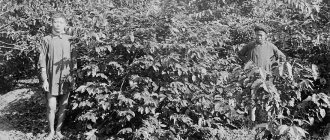- October 12, 2018
- Trees and shrubs
- Julia Master
Many novice gardeners dream of growing a coffee plant at home, but they consider it an exotic tree, the propagation and care process of which presents many difficulties. This opinion is erroneous, since growing a coffee tree is a completely accessible process for an amateur.
General information
The foliage of the coffee tree is not small, fleshy and has a greenish tint. Flowering begins and the plant produces an umbrella-like inflorescence consisting of approximately 76 flowers.
The flowers are white on small roots and appear on young annual stems. The fruits of the plant consist of two seeds, round in shape, initially having a yellow tint, turning into green. And the ripe fruits of the coffee tree are red. When the fruit ripens, it is covered with a crust on the outside, and inside is filled with sweetish, slightly sour pulp and a pair of seeds about 13 mm in length.
Home-grown coffee trees have beneficial properties. It can purify the air from harmful substances, increase and improve a person’s energy capabilities, reduce and relieve stress and put the nervous system in order.
From seed to seedling
In nature, the coffee tree grows up to 10 m tall, but on specialized farms the length of the branches is limited to 5 m - this increases the yield and simplifies the collection of ripe berries.
Some of them are selected for planting on plantations - the pulp is removed from such fruits. It is important not to damage the thin parchment shell around the core in the process. Before planting grain in the ground, it is first germinated. The coffee beans are dried, reducing the moisture level to 20%, and only then they are sprinkled with a thin layer of earth. The first shoots appear after 1.5 months; farmers transplant them into fabric bags with humus. Coffee peels or manure are added to the main soil, after which the sprouts are immersed a few centimeters into the ground.
This is a temporary shelter for future trees, in which everything is calculated down to the smallest detail. The bags are planted in a row, and a fence is placed along the plantation - a support for a canopy from the sun and rain. Coffee sprouts will have to spend about 10 months in greenhouse conditions.
- This is interesting: Coffee traditions around the world
As soon as the plant reaches a height of 0.5-0.6 m, it is transplanted to a permanent habitat. Maximum care must be taken so as not to damage the fragile root system. To do this, the bag is carefully ripped open, the plant along with the soil is moved into a previously excavated hole and lightly sprinkled with earth.
Types of coffee trees
The Arabian coffee variety , popular for growing at home, is a compact tree. The leaves are shaped like an elongated ellipse with a dark olive tint, glossy on the outside and pale on the inside. The inflorescences are small, about 2 centimeters in diameter, collected in a bouquet. The size of the inflorescences directly depends on the growing conditions.
Once opened, flowers remain fresh for only a few hours. But the buds gradually open, not all at once. After the inflorescences fade, the fruit ripens in the form of a berry; when ripe it has a burgundy hue. Ripening occurs approximately 8 months after pollination. The paired fruits resemble round beans. This species reaches a height of up to 5 meters.
Coffee dwarf Nana is a neat plant, reaching a height of about 85 cm. It blooms profusely and subsequently bears fruit well at home. The tree can be given the desired design by trimming and pinching the tops of the plant.
Liberian coffee is also grown indoors. Its ripe fruits have a scarlet or sunny slightly orange tint. The length of its leaves reaches up to 40 cm, and the height is adjusted and the required shape is formed by trimming the crown of the plant. The inflorescence has a light shade and large fruits - berries.
Propagation of a coffee tree by cuttings
It is easier to propagate plants using green cuttings. To do this, you need to prepare a soil mixture of equal parts of acidic marsh crumbs based on peat and perlite. It will allow oxygen and moisture to pass through well. It is also necessary to disinfect the soil with a manganese solution.
Further actions:
- From an adult tree, select a twig with four leaves from the middle part of the crown. It is better to take a cutting from a branch with bud embryos that grew last year. This way the future plant will enter the branching and flowering phase earlier;
- We cut the cuttings from the mother tree three centimeters below the foliage using a blade or sharp knife;
- On freshly cut pieces, under the outer two leaves, we leave longitudinal scratches with a needle. This will contribute to the accelerated formation of roots;
- Then we place the cuttings vertically with the lower scratched part for 3 hours in a root-forming mixture of a tablespoon of honey dissolved in a glass of water;
- Next, we plant the blanks in a pot with soil 2-3 cm deep (to the leaves) and cover them with a perforated plastic bag. Through the holes it will be possible to spray and ventilate the seedlings;
- You also need to protect the cuttings from the sun.
The most optimal temperature for rooting is +25-30 degrees with high air humidity. The main sign that the cuttings have taken root is the growth of the upper buds. And when a new pair of leaves appears, you can transplant them into a separate container.
Cuttings have a number of advantages:
- The young tree will have the same characteristics as the mother plant;
- Flowering occurs in the first year of planting;
- The first fruits appear within a year.
You can buy a young plant at a flower shop. Its cost will depend on the type, height and diameter of the pot. For example, the average price of a small specimen 30 cm high in a pot with a diameter of 12 cm is approximately 1000 rubles in online stores.
Caring for a coffee tree at home
The plant does not tolerate drafts and temperature changes. With proper care, you will enjoy fresh homemade coffee all year long.
The coffee tree prefers abundant, diffused lighting. The optimal location would be the southern part of the room. Constant ventilation is required in winter and preferable cultivation on loggias or terraces in the warm season. During the heating season, it is necessary to place the plant away from the radiator to avoid drying out the tips of the leaves. If there is insufficient lighting, it is necessary to use an artificial lamp.
The air temperature for the plant in summer should not exceed 25 degrees, and in winter it should not drop below 15 degrees. If you do not comply with the temperature conditions, the plant may lose its leaves and drop its buds.
The plant prefers regular spraying, and in the summer the plant needs to have a warm shower, this helps well with growth and active flowering. The humidity in the room should be high.
Watering in the summer is regular, allowing only one centimeter of the soil layer to dry, and in winter it should be reduced by one centimeter per week. Water for irrigation should be soft and settled, free of limescale, otherwise the plant may begin to hurt.
Transfer
For the first three years, the seedling must be replanted every spring. Then once every 2 or even 3 years. The pot gets bigger each time.
But even if the tree is not replanted, it is necessary to replace the top layer of soil with a new one.
If events develop successfully, in 1-2 years you can treat guests to coffee grown by yourself, and a photo of a coffee tree will decorate the gallery of achievements.
Indoor pomegranate: how to properly care for and grow? Reproduction, replanting and plant pests (120 photos)Muraya: types, description, care and cultivation at home. 140 photos and video instructions for maintaining a bush
Tea tree: growing at home. Indications and contraindications for the use of medicinal plants (115 photos + video)
Coffee tree diseases at home
- Why do the leaves of a coffee tree dry out ? The reason may be low humidity in the room and dry air. It is necessary to increase spraying and watering.
- Parasites can also attack the coffee tree, such as sooty fungus, scale and mealybug . Cobwebs and a white coating appear on the plant. You can get rid of them using a soap solution, after first destroying the infected leaves.
- Why do the leaves of the coffee tree turn yellow and begin to discolor . The reason for this is insufficient soil acidity.
- Why do the leaves of a coffee tree fall off and brown spots appear ? This indicates a lack of soil moisture.
- Necrosis of coffee tree leaves - occurs as a result of a lack of phosphorus and potassium, lack of light or dry air in the room. A sudden change in temperature in the room may also be the cause. With insufficient phosphorus fertilization, the plant slows down in development and leads to yellowing and falling leaves.
Conditions for growing coffee
Depending on how the coffee is grown and what protection methods farmers use, a high yield is achieved.
- Stable climate without seasonal temperature fluctuations. As a rule, plantations are preferred to be located in the equatorial belt.
- Loose soil. Coffee thrives on volcanic slopes thanks to the presence of organic remains.
- Temperature regime. 13-27 degrees Celsius above zero is the acceptable range within which fruits ripen according to schedule.
- Daylight. Trees love abundant but diffused sunlight.
- Sufficient amount of moisture. The area with annual precipitation of 3500 mm is considered the most comfortable.
Are there differences between how Arabica and Robusta coffee grow? The second type is not too whimsical, resistant to fungi. Therefore, breeders began to cross both varieties, creating a hybrid that was less susceptible to disease. This approach reduces the taste and aroma characteristics of the grains and, accordingly, is not in demand.
Your own coffee harvest from a houseplant
Want to learn how to create a mini coffee garden and how to care for exotic plants? Let's share tips. Growing seedlings yourself is a complex process. It is much easier to buy seedlings at a garden store. Usually they are sold in 5-6 pieces.
When you arrive home, remove the sprouts from the soil and leave the root system in a container with warm water overnight. Plant the seedlings in separate pots with loose soil, providing drainage with pebbles and sand. When the tree reaches a height of 20 cm, it should be transplanted into a larger pot; 50 cm requires a larger container. At 60 cm, an adult plant needs pruning - the growing tip breaks off.
Basic recommendations for care: maintaining humidity, good lighting, absence of drafts, fertilizing the soil (feeding with mixtures for citrus fruits). Statistics show: 1 grown tree with painstaking care produces 200 grams of coffee annually.











